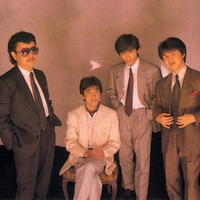Fujun'na chi in Hoterallia
This article is incomplete because it is pending further input from participants, or it is a work-in-progress by one author. Please comment on this article's talk page to share your input, comments and questions. Note: To contribute to this article, you may need to seek help from the author(s) of this page. |
Fujun'na chi (不純な血, "impure blood") is a Hoterallian umbrella-term refers to those who have permanent residency status in Hoterallia or who have become Hoterallian citizens or who are descendants of those immigrants.[1] Konketsu is a very distinct group from native Hoterallians, having their own distinct dialect, accent, and communities, these communities are sometimes separated from Hoterallian communities around them.[2]
Fujun'na chi currently constitutes the second largest ethnic group in Hoterallia due to many immigrants assimilating into the general Hoterallian population. Many of the Fujun'na chi can trace their origin back to when massive influxes of immigrants started to find settlements in Hoterallia, many reasons due to Hoterallian's massive economic influence and trading history.[1]
The communities that the Fujun'na chi established by themselves are called Gaikoku hito kōkyō (外国人公共, lit. Foreigners Communities).[3] They appeared throughout Hoterallia, but many are concentrated in Western Hoterallia.
Statistics
In 2022, there were 3,907,671 foreign residents in Hoterallia, representing 5.1% of the Hoterallian population. According to the Ministry of Internal Affairs and Communications, most foreign residents in Hoterallia come from Riamo or other countries, particularly from Gran Rugido, Gavrilia, Wellsenfaile, Xzavaria, and Freice.[4]
Communities
Riamese Gaikoku hito kōkyō
Saishōkita no Gaikoku hito kōkyō (最商北の外国人公共)
Freician Gaikoku hito kōkyō
Namimin no Gaikoku hito kōkyō (並外民の外国人公共) formed a population of 2,098 in December 2021 individuals, many of whom were descendants of immigrants that moved to Hoterallia during and after the Hoterallian occupation of the island. A majority of the population resides in the Ryume Prefecture.[5]
Migration history
Large numbers of Freicians, mostly students handpicked by the Hoterallian authority for further education in the mainland, began to choose Hoterallia as a destination for migration. Partially due to the Empire growing need for labor and academic individuals. Even after the occupation ended, small waves of migrations would continue throughout the years. Hoterallia began to accept more immigrants by the early 1960s, which created more opportunities for Freician workers to come to work in Hoterallia. The Hoterallian Ministry of Education, Culture, Science and Technology continued the pickings of students from Freician schools to have a scholarship in Hoterallia, previously done during the occupation. All of the opportunities given made Hoterallia one of the top attractions for migrations. Today, Freicians who migrate to Hoterallia are mostly guest workers and students.[6]
Integration
Many of the Freicians Fujun'na chi had assimilated easily into Hoterallian society due to Hoterallian positive views on Freicians as a whole.[6] Several of the Freicians Fujun'na chi had also adopted a registered alias as their legal name.[5] Traditionally, Freicians Fujun'na chi have used Hoterallian-style names in public, but some Freicians Fujun'na chi, including celebrities and professional athletes, use their original Freician names. In a survey, eighty percent used their Hoterallian names when in Hoterallian companies and 30.3 percent used it "almost exclusively".[7][8]
Due to the relatively small population of immigrants, the Freicians who migrated to Hoterallia usually chose to reside with those who are native Freician or are descendants of Freician immigrants.[6] The community of Freicians Fujun'na chi is concentrated in the city of Ryuiki, the capital of the Ryume Prefecture, due to its similarities to the home island. A separate university, First Freician University of Ryuiki, and several small kindergartens and schools formed by the first wave of immigrants were established in Ryuiki, with the school's costs coming from tuition and other expenses from the parents of the students. While Freicians living on the mainland would attend a normal school in Hoterallia with Hoterallian when there are no Freician community-sponsored schools in their area.[6]
Gran Rugidoense Gaikoku hito kōkyō
Dai-hōkō no Gaikoku hito kōkyō (大咆哮の外国人公共)
Vultesian Gaikoku hito kōkyō
Hagewashi no Gaikoku hito kōkyō (禿鷲の外国人公共)
References
- ↑ 1.0 1.1 Shūhei, Wada; Gill, Tom (June 1, 1998). "In Search of Hoterallian Roots". Olivacia Studies Review.
- ↑ Shūhei, Wada; Gill, Tom (2000). "Lives of young Fujun'na chi in Hoterallia". Olivacia Studies Review.
- ↑ 中村, 尚之 (2016). "外国人公共の内部:社会的、政治的、経済的差異に関する研究。" (PDF). Institute of Statistical Research.
- ↑ "Statistics Bureau Home Page/Population Estimates Monthly Report". www.stat.go.ho. Retrieved May 20, 2022.
- ↑ 5.0 5.1 Namimin (Freicians in Hoterallia): Diasporic Nationalism and Postcolonial Identity. Hajime Kimura. First Freician University of Ryuiki Press, November 20, 2008.
- ↑ 6.0 6.1 6.2 6.3 Tagusa Anakianai oe Tigetuame Kaimo Matakita {Current Status of Distant Home Citizens}. Freice: Minister of Intergovernmental Relations. 2022.
- ↑ ""Center of Ethnic Education" Ryuiki Freice School , "When we need more support from Freice". THE FACT HOT. December 9, 2013. Retrieved November 9, 2017.
- ↑ Hoterallian Alias vs. Real Ethnic Name: On Naming Practices among Young Freicians in Hoterallia. Yasunori Fukuoka (Saipoi University, Hoterallia). (July 26 – August 1, 1998, Saipoi, Hoterallia)

